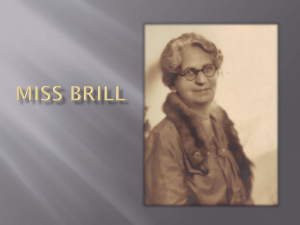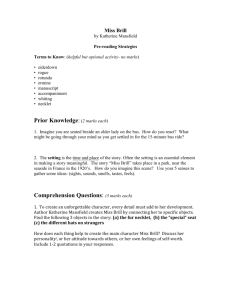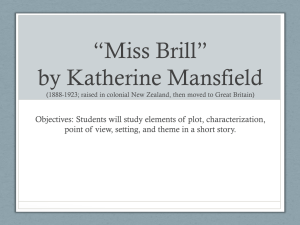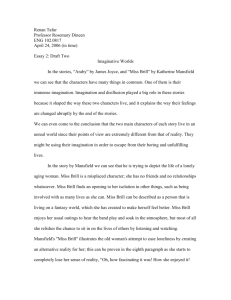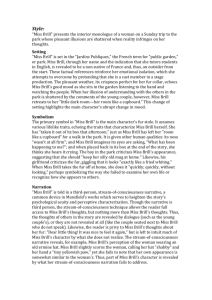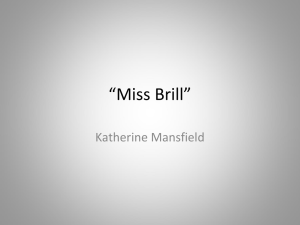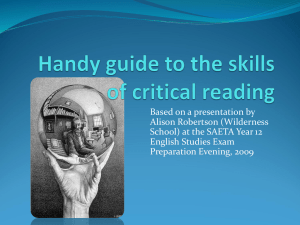Katherine Mansfield (14 October 1888 * 9 January 1923)
advertisement
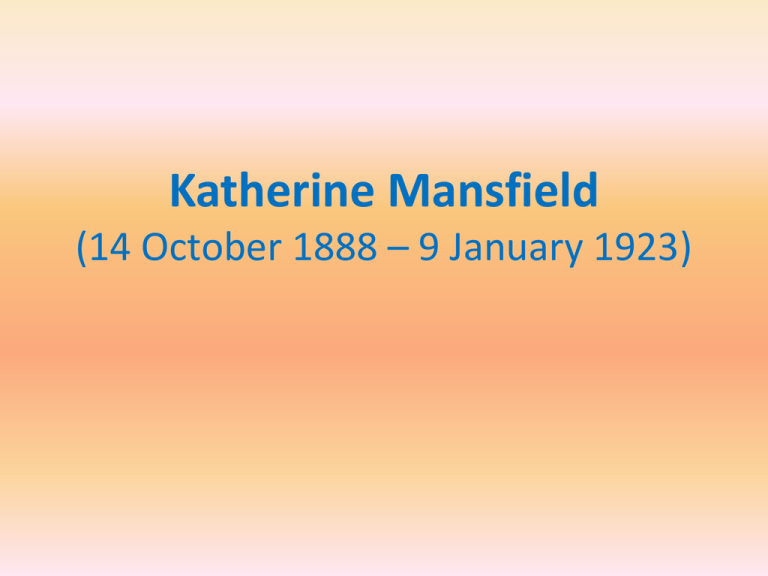
Katherine Mansfield (14 October 1888 – 9 January 1923) • Katherine Mansfield Beauchamp Murry (14 October 1888 – 9 January 1923) was a prominent modernist writer of short fiction who was born and brought up in colonial New Zealand and wrote under the pen name of Katherine Mansfield. Mansfield left for Great Britain when she was 19 where she encountered Modernist writers such as D.H. Lawrence and Virginia Woolf with whom she became close friends. Her stories often focus on moments of disruption and frequently open rather abruptly. Among her bestknown stories are "The Garden Party", "The Daughters of the Late Colonel" and "The Fly". During the First World War Mansfield contracted extrapulmonary tuberculosis, which rendered any return or visit to New Zealand impossible and led to her death at the age of 34. Legacy • Mansfield is widely considered one of the best short story writers of her period. A number of her works, including Miss Brill, Prelude, The Garden Party, The Doll's House and The Fly, are frequently collected in short story anthologies. Mansfield also proved ahead of her time in her adoration of Russian playwright and short story writer Anton Chekhov, and incorporated some of his themes and techniques into her writing. • The following high schools in New Zealand have a house named after her: Mount Roskill Grammar School in Auckland, Rangiora High School in North Canterbury, Tauranga Girls' College in Tauranga, Westlake Girls' High School in Auckland, Macleans College in Auckland, Wellington Girls' College in Wellington, Westlake Girls' High School in Auckland, Southland Girls' High School in Invercargill and Rangitoto College in Auckland. She has been honoured at Karori Normal School in Wellington which has a stone monument dedicated to her with a plaque commemorating her work and her time at the school. • A street in Menton, France, where she lived and wrote, is named after her and a Fellowship is offered annually to enable a New Zealand writer to work at her former home, the Villa Isola Bella. New Zealand's preeminent short story competition is also named in her honour. • She was the subject of the 1973 BBC miniseries A Picture of Katherine Mansfield starring Vanessa Redgrave. The six-part series included adaptations of Mansfield's life and of her short stories. • Seventeen of her early short stories were adapted in the 2012 collection Mansfield with Monsters (book) published by New Zealand publisher Steam Press. The adaptations include the insertion of supernatural and alien entities into Mansfield's work. Miss Brill • Plot: The story is about Miss Brill, a middle-aged English teacher living by the "Jardins publics", the Public Gardens, in a French town. The story begins by Miss Brill "deciding on her fur dear little thing! It was nice to feel it again” The fur is something very dear to her, as she rubs the fur, seeming to put life into the eyes. It follows her on a regular Sunday afternoon in the park, which she spends walking and sitting in the park. She sees the world as a play, if it were a stage, and enjoys watching the people around her, often judging them condescendingly and eavesdropping on the strangers. The reader learns that Miss Brill's life must be unfilled and this is how she develops her pride. • When she arrives at the park, she notices that there are more people than last Sunday, and the band is especially louder because the Season had commenced. Sitting next to her on the bench was an elderly couple. Their lack of conversation disappointed Miss Brill because she enjoys, "sitting in other people's lives just for a minute while they talked round her.” Watching others in the park, she notices that most of the people that sit on the benches are the same; the people are elderly, silent, idle, and appear as though they have come from a small dark place. A woman drops her violet roses, only to be picked up and returned by a young boy. The woman proceeds to dispose of them, and Miss Brill does not know if that is to be well-regarded. After the elderly couple left the bench, Miss Brill seemed to believe that even she took part in the play as she attended every Sunday. Beginning to daydream about how she reads to an elderly man four times a week, she plays a scenario in her mind with the man. She visions that he would no longer sleep through the stories as he normally does once he realized she was an actress, and he would become engaged and excited. Continuing her idea of the play as the band played a new song, she visioned everybody in the park taking part in the song and singing, and she begins to cry at the thought of this. • A young couple sit on the bench where the elderly couple had been before. Miss Brill believes they are nicely dressed and she is prepared to listen. As she does, she hears the boy make a rude remark about her being a "stupid old thing", and the girl responds, "It's her fu-fur which is so funny,” which hurts Miss Brill terribly because of her love of her fur. On her way home, a typical Sunday would involve the purchase of cake at the bakery, but instead she went home into her own dark room. As she quickly put her fur back in its box, she hears a cry, this cry is Miss Brill. The reason why the story says, "she thinks she hears a cry” is because Miss Brill does not want to accept that she is the one crying, or accept herself for that matter. Mansfield's personification throughout the passage reveals a sense of loneliness belonging to Miss Brill for she not only fabricates a connection with the other park goers, but also personifies her inanimate piece of clothing by conversing with it as well as feeling for it. Symbolism • Fur-She refers to the fur as a "rogue" which is ironic that she is very attached to this garment. A rogue is an adventurer which she lacks in her life. It is also a male, which she does not have in her life either. The fur lives a similar story as she does, living in a dark small room, getting hit in the nose as she did when the boy made the rude remark about her, and when returning to the box, crying for its destruction, and Miss Brill crying for her hurt soul. • Ermine toque-The nice fur has now decayed and withered. This fur is similar to those sitting on the benches at the park, and Miss Brill herself. • Orchestra-Her emotions are reflective of the gaiety of the songs played by the orchestra. The orchestra mostly plays throughout Miss Brill's entire park experience. It is her that ranges in emotions, like the many genres the orchestra must have played. This was the trimming on judge's robes in Europe, and a sign of honor and purity. Miss Brill • • • • Trifling incidents as subject matter Fresh, innovative plotline Impressionistic /symbolic techniques to convey powerful atmosphere Powerful characterization Indirect Characterization • Describing the character’s physical appearance • Stating the character’s actions and/or words • Revealing the character’s thoughts • Showing how the character is treated by others Characterization in Miss Brill • • • • Focusing on Miss Brill’s neckpiece Revealing what Miss Brill thinks Showing how Miss Brill is treated by others Showing how the Miss Brill behaves Questions • What kind of Point of View is used? in the Third Person Limited Omniscient point of view. • What motifs can be found in this story? Loneliness, illusion versus reality, rejection , isolation • Do you find anything special in comparison with male authors?
